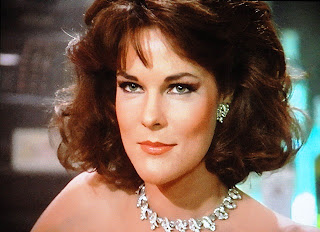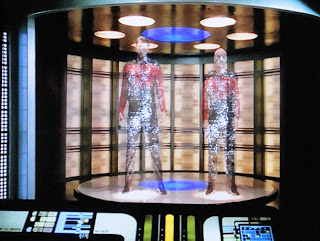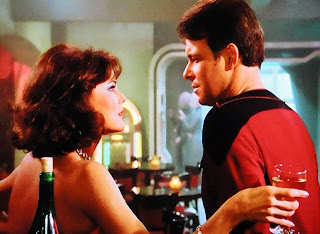"It is me. It's what I am."
-Number One to Minuet fully aware of who he is as a Commander for the Federation. But are Minuet and The Binars self-aware?-



And speaking of Riker, Jonathan Frakes offered some hope for the future of Star Trek: The Next Generation to Starlog Magazine contributing writer Kathryn Drennan (once married to genius J. Michael Straczynski of Babylon 5 acclaim and running parallel to Star Trek: Deep Space Nine), despite some missteps along the way in Season One. "Things are wonderful on our ship, as a rule. The conflict comes from what we encounter, you know, when we boldly go where no one has gone before, where things are not quite so rosy. I don't believe we'll have any trouble finding places, people and situations that we'll have conflict with, in spite of our Utopian existence" (Starlog Magazine #131, p.33).


And therein existed the problem for ST:TNG in the first season. Everything seemed just a little too harmonious, perfect and self-satisfied aboard the sometimes overly content Enterprise-D. But things are changing. Good, solid episodes are beginning to make their way aboard this ship and righting its course as she goes. 11001001 sees the crew find conflict of a sort or, in effect it finds them. Riker may have missed the Holodeck fun of The Big Goodbye but his missed opportunity there offers him a chance to shine here in the latest Holodeck-centric episode.


Following the lackluster and preachy effort that was Angel One, Star Trek: The Next Generation arrives at Starbase 74 off Tarsas III in glorious fashion. The opening shots of latest entry, Star Trek: The Next Generation, Season One, Episode 15, 11001001, are impressive of the Enterprise-D docking. The sharp, cleaned and polished optical effects look amazing as if they were created today. The story opens with a bit of continuity too noting the problems encountered with the Holodeck during strong Season One episode The Big Goodbye (ST:TNG, S1, Ep12). 11001001 was originally intended to pre-date The Big Goodbye as the cause of that episode's technical problems, but was reversed.
Captain Jean-Luc Picard and Commander William Number One Riker are met by Orfil Quinteros, played by Gene Dynarski. Dynarski, of course, once appeared on Star Trek: The Original Series in Mudd's Women (ST:TOS, S1, Ep) as well as The Mark Of Gideon (ST:TOS, S3, Ep16).


The crew of the Enterprise are introduced to an alien race known as the Binars (as in binary numbers or establishment in pairs of two) who always work in pairs. 10 and 01 are introduced to repair and upgrade systems on the Starfleet ship. The Binars, for organic beings, through evolution, have mastered and become so interconnected with the computer of their homeworld that their thought patterns and language are essentially binary in nature.
And in the spirit of ST:TOS, the Binar roles are performed by actresses in much the same fashion as The Talosians of Talos IV in ST:TOS, Episode 11/12, The Menagerie.



The behavior of the Binars is indeed odd and appears suspicious almost from the outset, but is that merely the natural behavior of an alien race never before encountered? Jonathan Frakes continues to grow more comfortable in his role as Commander William Riker and he's the perfect leader of this Enterprise to carry embody a suspicious and questioning nature. He's an intimidating but respectful presence. Almost from the outset, he has his concerns regarding the Binars. Why couldn't Riker have been more in tune with the behavior surrounding Lore in Datalore (ST:TNG, S1, Ep13)? This speaks to some of the unevenness of Season One. Only Wesley Crusher suspected Lore in the aforementioned episode. Here, Wesley notes Number One's cautions but has none of his own despite the appearance of subterfuge here by the Binars.
My re-immersion into the ST:TNG Season One experience via Blu-Ray has noted the vivid recreation of the images from this classic series. I must also note the audio has improved as well and the theme song composed and scored by Dennis McCarthy is simply a powerhouse of reconstruction on the themes of ST:TOS. Wonderful stuff really.

It's also worth noting that the pronounced sharpening of the series' colors makes me realize the sterner use of reds and yellows in the Starfleet uniforms is in stark contrast to the blue, yellows and reds of ST:TOS. The two series genuinely differentiate themselves in style and color palette. That separation is an entirely smart move on the part of the creators to formulate the look of a series that would one day stand on its own. This significant production contrast is indeed noteworthy.

The latest episode also establishes an interesting character differentiation between Picard and Riker. Picard is a thoughtful, reflective man inclined to have focus in deeper more probing reflections on his off time. Riker is more spontaneous, more open to casual, unexpected and less cerebral delights. He has a more robust enthusiasm for the women of the Holodeck too. Carolyn McCormick (the Law And Order franchise) is featured here as the sultry Minuet, a stunning beauty, as Riker continues developing a reputation for the ladies, fictional or otherwise in a smoky jazz club. The Minuet character would return for Future Imperfect (ST:TNG, S4, Ep8). Riker was often unfairly categorized as the new James T. Kirk early on, but it's clear he does embody some of the very best of the former Captain's traits for the opposite sex. He's been a charmer. Fittingly, a minuet is a social dance of 17th Century French origin between two participants. Let the dance begin.


The Binars are clever too utilizing Riker's predisposition for the ladies by distracting him within the Holodeck while they create a red herring to empty the vessel by faking a shield breakdown.
Picard finds Riker digging into Minuet. Can you blame him? If she's indeed purely fiction would one be cheating on the real other half by diving into the wonders of a virtual world? When we dream do we not think of men and women from our respective pasts? I'm reminded of Bob Newhart from Newhart (1982-1990) having a dream of another woman. Hearing him talk in his sleep, his wife refused to speak to him for his dreaming infidelity and clearly involuntary actions that included impure thoughts. Mind you, the Holodeck is completely pre-programmed accordingly and the recipient of that programming is an undeniably willing participant.



Later, the appropriately French-speaking Minuet brings out Picard's inner Parisian as he joins Minuet and Riker. Now the writers cleverly tap into the concept of a minuet as a musical composition, also pronounced in the episode. The form can lead to a structure called minuet and trio as the form is known and ST:TNG cleverly captures these concepts through the performance dynamic with the focus on Minuet, Riker and Picard as the orchestrated dance continues and plays out. This minuet form structure is also called rounded binary further weaving the components of this intelligent entry.
Meanwhile, Data and Geordi La Forge are summoned to check on a magnetic, anti-matter containment field issue concerning a potential catastrophic failure of the warp core and are forced to abandon ship and program the Enterprise to reach the furthest distance possible to avoid harming neighboring planets.


Data auto programs the departure of the Enterprise. Only Picard and Riker have not been evacuated. Once again, the Holodeck presents its fair share of conundrums. It's in the hands of Picard and Riker to resolve the imminent crisis aboard their Enterprise. Now if they could only break free of the lure of Minuet. The Binars have upgraded the Holodeck and created a very intuitive program in the form of Minuet. Only when Minuet makes forceful attempts to keep Picard and Riker within the Holodeck do they realize something is amiss.
Picard and first officer Riker determine the Enterprise has been hijacked by the Binars to return the race back to their homeworld.


There is an excellent visual moment as Picard and Riker walk in tandem to regain the ship that has been commandeered by the Binars. It symbolically echoes the race of the Binars to work in pairs. Clearly, the creators, here, capture this visually as two honed commanders in the form of Picard and Riker work as a determined pair too in order to save their ship and counteract the Binars. In unison, Picard and Riker establish auto-destruct. Together they will succeed in overtaking the vessel or they will die together. Both in red uniforms and with sheer determination to usurp command of their vessel, there are indeed visual cues to suggest this is the Earth equivalent of the Binars own paired relationships. They will have five minutes to succeed. 11001001 is potentially one of the smartest and literate scripts to date.
Picard and Riker question why as they beam onto the bridge and shut down auto-destruct. The Binars are disabled. Picard and Riker turn to Minuet for answers. They discover the Binars main computer is at risk from a star gone super nova. The effort was to store all of their civilization's information on the Enterprise as a computer back-up and then restore it back to their homeworld.


Working as in conjunction as a pair, Picard and Riker restore the data to the Binars' world. The Binars are saved. Picard and Riker were tucked away for safekeeping in order that they might restore the file upon arrival for the Binars. Their plan worked. Picard and Riker wonder why they simply didn't ask for help. The simple answer is they could not risk an answer of "no." The risk was a matter of life and death and stealing Federation property was a calculated risk, a dance they were willing to take.
Riker returns to the Holodeck to find Minuet is gone. Picard tells Riker, "Some relationships just can't work." Riker responds, "She'll be difficult to forget."


It's clear by the ideas established in 11001001 that the writers and creators of Star Trek were onto something concerning a race of beings so interconnected to computer technology. The introduction of the Borg in Season Two was a logical next step. It was also a master stroke of creative ingenuity to generate a hive-like race even more sophisticated than the Binars that are completely immersed with technology. The Borg would be the perfect villain as a threat not conventionally designed as a villain disinterested in harming, but rather a lethal one designed and operating to improve and collect everything in its path for the betterment of a collective. The Binars haven't evolved to that place but it does present an interesting missing link regarding organic development in understanding the complexities of a creature like the Borg. The Binars present in many respects an evolutionary link of what could come next? It's like a clue of things to come for the Star Trek fan.


On a purely entertainment level, 11001001 is like a smart adaptation of virtual sex. It gives new meaning to stimulation simulation. Most of all, 11001001 enjoys a wonderfully relaxed approach to the many facets of its characters with a delightful focus on Picard and Riker. But it has a very natural feel throughout the story often missing in the first half of Season One, which often felt preachy, forced and even, at times, forced, wooden or the work of over thinking. 11001001 is a solid first season entry with a respectable story or as Larry Nemecek wrote in the Star Trek: The Next Generation Companion, it was "another sign that both script quality and overall continuity were on the rise."


Despite all of ST:TNG's flaws in Season One I'm continually drawn back to it. I wouldn't be bringing you each new entry if I wasn't captivated even with its flaws. Does that seem logical? Missteps aside it still remains an engaging, fascinating world and one that, even with its weaknesses, pulls me back every time. That alone tells you something special is going on here. 11001001 is a thoughtfully processed Season One executable and definitely one of the best to date.


11001001: B-/B.
Writer: Maurice Hurley, Robert Lewin.
Director: Paul Lynch.


















5 comments:
Easily, this was one of my favorites in the initial season where ST:TNG was still finding its footing. S1 cannot be counted as one of my most-liked. Still, Carolyn McCormick as Minuet would, from this one show, haunt the series in a good way. When she would reprise the character in 'Future Imperfect' (season 4), as a key reveal that clues Riker, that was most satisfying. Great look at this, G. Well done.
Nice examination of this episode. When I revisited the series, this episode really stood out in my mind. Loved all the different levels in the story, and you pointed out a few more I didn't notice before.
Your note about the design of the series and the way the color palette was different was a good one. It's something I attributed to it just being grounded in the late 80s, but I think you're right on the money saying this was a conscious decision by the creators.
Finally, I really love your point about the Binars being a proto-type for the Borg. Very interesting connection. It seems like the kernel was planted here.
Cheers both.
I definitely took the examination of the color palette and ran with those personal observations.
I've read of the Borg connection in places and it certainly stands to reason and thus expanded on it accordingly with my own input.
It's like The Binars were a closed network and the Borg became a much more expansive concept bringing the idea of wide area networking into the theme of assimilation.
I enjoyed this episode very much as well.
I haven't seen this episode yet. I just picked up a Season One: Next Gen the other day, but have been too busy with other stuff to dive into it.
I think Next Gen does have many good episodes, but did start out rather bland or uneven--I never cared for Q (I would have preferred an actor that was more strong in character.). One other criticism of Next Gen for me was they steered clear of (it seemed) any hand to hand combat like TOS. I found this a bit odd really.
They used to show Next Gen fairly late at night for a while, and it was a way to see a few episodes I'd missed and re-view ones I'd already seen, however, they've since stopped that. It was a good nightcap way to end the day though.
El Vox,
You make some ther good differentiations between TOS and TNG.
I can definitely understand picking up Season One at a reduced price though I'm big on reduced prices on just about anything given the expense of Star Trek on Blu-Ray. But TNG does look terrific on Blu-Ray making it worth the expenditure.
Cheers El Vox.
Post a Comment